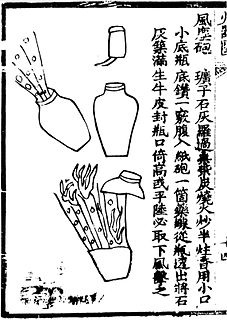
A bomb is an explosive weapon that uses the exothermic reaction of an explosive material to provide an extremely sudden and violent release of energy. Detonations inflict damage principally through ground- and atmosphere-transmitted mechanical stress, the impact and penetration of pressure-driven projectiles, pressure damage, and explosion-generated effects. Bombs have been utilized since the 11th century starting in East Asia.
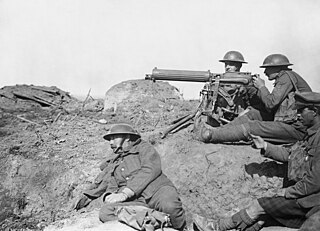
Technology during World War I (1914–1918) reflected a trend toward industrialism and the application of mass-production methods to weapons and to the technology of warfare in general. This trend began at least fifty years prior to World War I during the American Civil War of 1861–1865, and continued through many smaller conflicts in which soldiers and strategists tested new weapons.

Stielhandgranate is the German term for "stick hand grenade" and generally refers to a prominent series of World War I and World War II-era German stick grenade designs, distinguished by their long wooden handles, pull cord arming and cylindrical warheads. The first models were introduced by the Imperial German Army during World War I and the final design was introduced during World War II by the German Wehrmacht.
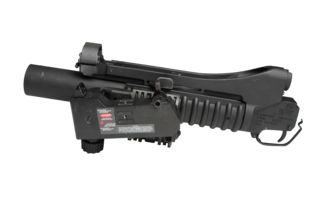
The M203 is a single-shot 40 mm under-barrel grenade launcher designed to attach to a rifle. It uses the same rounds as the older stand-alone M79 break-action grenade launcher, which utilizes the high-low propulsion system to keep recoil forces low. Quite versatile and compatible with many rifle models, the M203 was originally designed for the U.S. M16 and its carbine variant, the M4. The launcher can also be mounted onto a C7, a Canadian version of the M16 rifle; however, this requires the prior removal of the bottom handguard.

This is a list of aviation-related events from 1912:
A rifle grenade is a grenade that uses a rifle-based launcher to permit a longer effective range than would be possible if the grenade were thrown by hand.
Nils Waltersen Aasen was a Norwegian arms inventor. He has been credited with having developed the modern hand grenade and land mine just prior to World War I.

The Ordnance SBML two-inch mortar, or more commonly, just "two-inch mortar", was a British mortar issued to the British Army and the Commonwealth armies, that saw use during the Second World War and later.
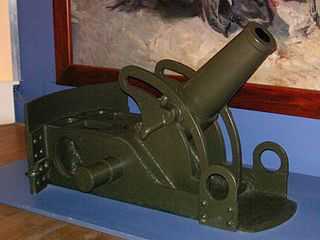
The Mortier de 58 mm type 2 or Mortier de 58 mm T N°2, also known as the Crapouillot or "little toad" from its appearance, was the standard French medium trench mortar of World War I.
INDUMIL is a Colombian-based military weapons manufacturer. The company is run by the Colombian government.

An aerial bomb is a type of explosive or incendiary weapon intended to travel through the air on a predictable trajectory. Engineers usually develop such bombs to be dropped from an aircraft.
In military munitions, a fuze is the part of the device that initiates function. In some applications, such as torpedoes, a fuze may be identified by function as the exploder. The relative complexity of even the earliest fuze designs can be seen in cutaway diagrams.

A grenade is an explosive weapon typically thrown by hand, but can also refer to a shell shot from the muzzle of a rifle or a grenade launcher. A modern hand grenade generally consists of an explosive charge ("filler"), a detonator mechanism, an internal striker to trigger the detonator, and a safety lever secured by a cotter pin. The user removes the safety pin before throwing, and once the grenade leaves the hand the safety lever gets released, allowing the striker to trigger a primer that ignites a fuze, which burns down to the detonator and explodes the main charge.

The Aasen mortar was a 3.5-inch (88.9-mm) gun-mortar. The Aasen was invented in France in 1915 by Nils Aasen, a Norwegian arms designer. It was adopted by the Russian Empire in 1915-1916, and was used during the First World War.
An anti-tank grenade is a specialized hand-thrown grenade used to defeat armored targets. Although their inherently short range limits the usefulness of grenades, troops can lie in ambush or maneuver under cover to exploit the limited outward visibility of the crew in a target vehicle. Hand launched anti-tank grenades became redundant with the introduction of standoff rocket propelled grenades.
A delay-action bomb is an aerial bomb designed to explode some time after impact, with the bomb's fuzes set to delay the explosion for times ranging from very brief to several weeks. Short delays are used to allow the bomb to penetrate before exploding: "a delay action bomb striking the roof of a tall building will penetrate through several floors before bursting". A short delay would also prevent a fighter-bomber or ground-attack aircraft getting caught in the blast of its own bomb after a low-altitude attack. Longer delays were intended to disrupt salvage and other activities, to spread terror in areas where there could still be live bombs and to attack bomb disposal workers.

The Breda Mod. 35 is a hand grenade issued to the Royal Italian Army during World War II.
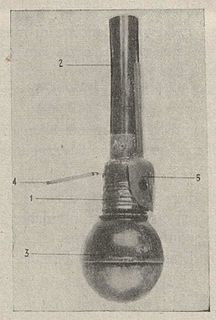
The Breda Mod. 42 was an anti-tank grenade, developed by Breda, supplied to the Royal Italian Army during World War II.

Passaglia Grenades, also known as P Bombs or Pazzaglia, are homemade weapons used by Italian soldiers during World War II, especially in the North African theater to overcome the chronic lack of effective weapons against armored enemies.
The bombing of Barcs was a military air attack of the Yugoslav Air Force on the Hungarian town of Barcs that occurred on 27 October 1991.












